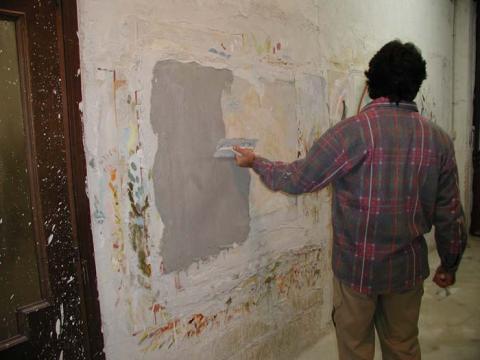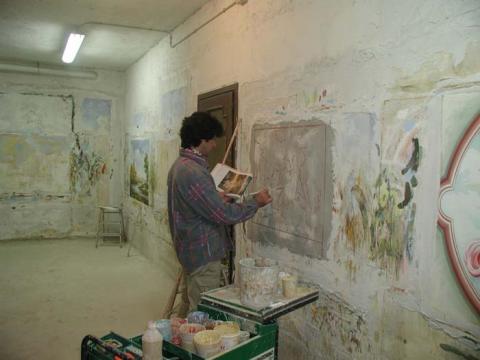FRESCO - A NEW - OLD TECHNIQUE
How we transport our works
The Calicot method to remove and transport frescoes
Our frescoes are all realized by our artists in their own studios. This means that, to reach your home, they need to be shipped: of course, we cannot ship them attached to the wall they have been painted upon. For this reason, we use a special technique, called Calicot method or, to say it in Italian, la tecnica a Strappo. This technique, which is recognized by the Superintendence of Fine Arts, has been around since the 17th century and is one of the techniques used in those cases when, for the safety of the piece, a fresco needs to be removed from its original location.
How does it work?
It is, in words, a relatively simple mechanism and, in practice, one of the least invasive available to transport frescoes, because it only acts upon the plaster layer where colors are absorbed, leaving the actual plaster base (called arriccio) untouched. The painting to transport is covered with a panel made with cotton canvas and animal based glues, upon which a stronger canvas, larger than the actual painting, is then placed. A large incision is then practiced all around the painting, well into the supporting wall.
Light blows with a rubber hammer upon the area help the detachment of this thin layer of pigments and plaster, which are then “torn” away from the wall (hence the name “strappo”, tear, in Italian) with the glue and canvas structure. The back of the fresco is thinned to remove all extra plaster, and a proper frame structure is attached to the front canvas, then covered with two layers of mortar, which form the real support to the fresco now fully detached from the wall. Once the mortar is dry, it is covered with glue used to stick the fresco upon a safe rigid support, which is, in our case, a strong canvas.
Once the structure at the back of the fresco is entirely dry, the protective cotton and canvas layers applied on top of the fresco in the early stages of the procedure are removed by vaporizing water and ethylic alcohol on the surface. This done, the fresco in ready to be admired! All of the items on this web site were first painted on a stone or masonry wall, on fresh plaster and then removed from the wall using the above technique.
Fresco painting is a very old technique. It reached the height of splendor during the Renaissance and was used to decorate buildings and church vaults. A fresco is painted on fresh (fresco) plaster made of slaked lime and sieved siliceous river sand, plus pigments diluted with plain water. The painting must be done quickly and skillfully, before the plaster base dries.
No binding agent is used in frescoes: this is because the painting is fixed and made insoluble by the chemical reaction between the calcium hydrate and the carbonic acid in the atmosphere. Frescoes, it has to be remembered, are different from murals, which are painted on a dry base.

Above: Sergio Bonometti applying the fresch plaster to his studio wall
Why we do not paint directly on the canvas
Some may wonder why we do not lay plaster directly on a portable canvas and skip altogether the Calicot procedure to strip the fresco from a wall. The answer is simple: plaster does not stick to canvas so, in order to “make it stick”, we should mix it with solvents or glues. The addition of these substances would greatly change the appearance of the painting, especially the intensity and depth of its colors.
To maintain the fresco just as it was conceived and created by the artist, we use the Calicot technique, through which we remove the plaster’s superficial layers – those retaining the actual painting – from its wall support, and glue it to a transportable canvas. By doing so, we only need to use color pigments mixed with sand to create our works: if you are a fan of the “antique look”, you will love the results.
The fresco technique gives our items soft colors and the same look as frescoes painted hundreds of years ago. Believe us: photos and a computer screen do not pay tribute enough to the beauty and uniqueness of these items, which do not look like oil or acrylic painting at all.

Above: Sergio Bonometti making a drawing of the future fresco painting
Why portable (Panel) frescoes?
The way a fresco looks and feels is very different from an oil paintings or a mural. Frescoes, for instance, do not have colors as bright as a mural: anyone who visited Italy, and Europe in general, will notice immediately the difference between, for example, a Diego Rivera mural and a fresco. If you want a room that makes you feel like you are in Italy, then a frescoed wall is the way to go.
And if this is what you would like for your home, then getting one or two of our frescoes is an easy way to achieve a perfect result, in an inexpensive way: hang them in your room and they will give it the look and feel of Italy. It is certainly cheaper than flying Sergio and Giovanni to your place and feeding them for a week, that’s for sure!
Also, fresco panels are portable, which means you can always carry them with you if you ever decide to move. All frescoes on this web site are painted by Sergio Bonometti or the members of his Art Centre.

Above: Sergio Bonometti making and coloring the fresco
Our Art Director
After graduating from the Caravaggio Art School in Brescia, Sergio Bonometti attended the Brera Academy of Fine Arts in Milan, one of the most prestigious Fine Arts Academies in the country. Here, he honed his artistic skills, working alongside famous fresco painters for the renovation and decoration of palaces, villas and large hotels. Sergio Bonometti's twenty years experience and artistic qualities are the motor behind B&B Affreschi, which could not be without his talent and supervision.
Frescoarte and Lifeinitaly guarantee our frescoes are made in Italy by professional painters, following traditional techniques for their realization and approved methods for their transportation.
